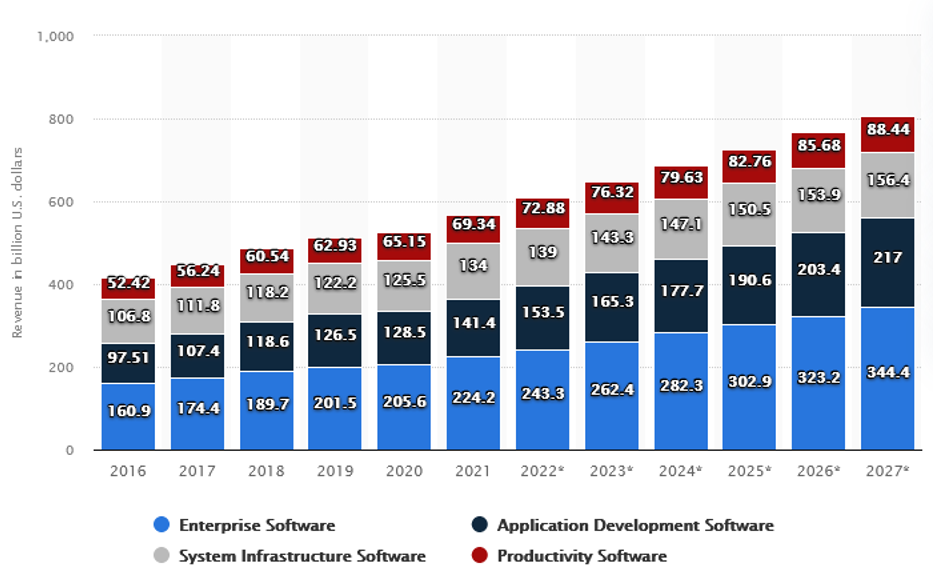
Software development is the foundation of innovation in our technology-centric world. It’s impossible to overestimate the significance of software, from improving user experiences to expediting corporate operations. We explore the requirements, cost factors, typical hazards, kinds, creative methods, understanding software development cost saving techniques, and closing insights into software development in this extensive book.
The Significance of Software Development
The foundation of contemporary technology is software development, which enables companies to improve efficiency, optimize processes, and provide outstanding consumer experiences. Enterprise software has the largest share of the overall software market, with worldwide revenues amounting to over $200 billion in 2021, according to the Statista Technology Market Outlook. Here’s the complete market breakdown for the years 2016-2027:

Source: Statista
Software development also promotes data-driven decision-making, which uses insights from huge datasets to guide strategic choices. Additionally, networking and collaboration are made possible, removing geographical obstacles and promoting efficient teamwork. Software development also improves client experiences, which promotes happiness and loyalty. All things considered, software development is necessary for long-term success in the current competitive environment as well as digital transformation.
Understanding Software Development Cost Factors
A lot of variables affect how much does it cost to make an app, and each one is important in figuring out how much will custom software development cost in total. Throughout the development lifecycle, these variables influence resource allocation and budgetary issues. Now let's examine the main factors:
| Complexity of Requirements | One major factor influencing development expenses is the complexity of the features and functions that are sought. Projects having a lot of needs, including those with complicated algorithms, user interfaces, or integration capabilities, usually take longer to build and have increased costs to develop software. |
| Technology Stack | Development costs are greatly impacted by the infrastructure, programming languages, and frameworks chosen. When compared to open-source alternatives, using proprietary or cutting-edge technology may result in more development or licensing prices. Compatibility and scalability factors also impact technology selections, which further impacts total software development cost. |
| Composition of the Development Team | A key consideration in cost estimating is the development team's size and level of experience. While a larger team with more experienced designers, project managers, and software engineers may cost more to hire, they may guarantee better results and speed up development times. On the other hand, smaller teams or outsourced arrangements could be more cost-effective, but they still need to be carefully managed to preserve production and efficiency. |
| Integration Requirements | Including third-party services or current systems in the development process adds expenses and complications. Comprehensive planning, development, and testing efforts are necessary to ensure smooth data interchange and compatibility across various software components or external platforms, which might result in increased software development costs. |
| Maintenance and Support | An essential part of the total software development cost is post-launch maintenance, upgrades, and customer support. Bug patches, performance improvements, and feature additions are examples of continuing maintenance tasks that need specialized personnel and continuous financial outlays. Furthermore, the total software development cost is increased by offering prompt and efficient customer support services, especially for mission-critical or consumer-facing systems. |
Types of Software
Software encompasses a diverse array of applications catering to various needs and industries. Major types include:
- Web Applications: Web apps provide a variety of features that are available on many platforms and devices simultaneously. All through the web browser. Web apps typically are created with technologies like HTML, CSS, and JavaScript. They provide consumers with accessibility and flexibility by enabling them to engage with services and information without the need for installation. Social networking networks, e-commerce websites, and online banking portals are a few examples.
- Native Applications: Programming languages and frameworks specialized to a given platform are used to create native apps for particular operating systems, like iOS or Android. These apps enable seamless interaction with device features and capabilities, tailored for performance and operation on their respective platforms. App stores are commonly used for the distribution of native apps, which offer a standardized user interface specific to the intended operating system. Multimedia apps, productivity tools, and mobile games are examples.
- Cross-Platform Applications: With a single codebase, cross-platform apps may function on several operating systems as native apps. This allows the developers to reach a larger audience with less work. These apps provide common components that can be distributed on several platforms by utilizing frameworks like Xamarin, Flutter, and React Native. Cross-platform development shortens time-to-market and simplifies the development process by abstracting platform-specific complications. Software for corporate administration, communication tools, and productivity apps are a few examples.
Various software types have different benefits and things to keep in mind based on the project's goals and needs. Organizations may select the best strategy to fulfill their goals and provide outstanding user experiences across a variety of platforms and devices, regardless of the benefits of web applications, native apps, or cross-platform development.
The Software Development Process
A methodical strategy for developing, implementing, and managing software applications is known as the software development process. It entails a set of organized procedures and approaches to produce software products of the highest caliber that satisfy user requirements and expectations. Let's examine each phase of the process of developing software:
- Requirement analysis: Knowing the project's requirements and goals is the first stage in the software development process. This entails obtaining what your future clients might actually need. The purpose of requirement analysis is to specify the software product's features, functions, and scope while making sure that they are in line with user expectations and corporate objectives.
- Planning and Design: At this stage, the development team plans and creates the project plan, milestones, and the software's technical architecture. Specialists work with an emphasis on usability and scalability. Design considerations include user interface design, database schema design, and system architecture design.
- Development and Testing: After putting together the project plan and design, the development stage begins. The team programs the code in accordance with the design guidelines established in the previous step. Simultaneously, extensive testing is carried out to find and fix any bugs in the program. Testing includes a range of methods to make sure the software product is reliable and secure, such as unit, integration, and system testing.
- Deployment: The program is prepared for installation in a production setting when development and testing are finished. Here, you’ll need to Install the program on servers, set up databases, and configure infrastructure. You can deploy your software to the cloud or your own hardware, depending on the project's requirements. Don’t forget to take scalability, dependability, and security into account.
- Maintenance and Updates: Following deployment, the program moves into the maintenance phase, during which time it receives regular updates, maintenance, and support to guarantee its operation and performance. Bug repairs, security patches, performance upgrades, and feature additions based on user input and changing needs are examples of maintenance tasks. Maintaining the software's relevance in a changing market, fixing new bugs, and enhancing user experience all depend on routine upgrades and maintenance.
Successful project management, cooperation, and good communication are critical throughout the software development process. Through adherence to a methodical strategy and utilization of optimal techniques and procedures, establishments may optimize their software development endeavors, alleviate hazards, and furnish superior software solutions that satisfy users and stakeholders.
Strategies for Software Development Cost Optimization
To reduce development expenses without sacrificing quality, take into account the following tactics:
- Prioritize Features: To cut down on development time and expenses, concentrate on key features (MVP) that are in line with company goals.
- Make Use of Open-Source Tools: To save on software development costs and shorten time to market, make use of open-source frameworks, libraries, and platforms.
- Outsource Non-Core Activities: To maximize resource allocation, assign non-core duties to outside vendors or specialized organizations, such as design, testing, or maintenance.
- Adopt Agile approaches: Reduce project risks and expenses by embracing agile development approaches to improve responsiveness, flexibility, and cooperation.
Conclusion
A complex process, software development is essential to digital transformation, innovation, and competitiveness. Organizations may confidently traverse the software development environment, achieve their technology goals, and propel corporate success in the digital era by comprehending the nuances of software development, avoiding typical errors, and using cost-effective techniques.
Related Posts
Share this post
Leave a comment
All comments are moderated. Spammy and bot submitted comments are deleted. Please submit the comments that are helpful to others, and we'll approve your comments. A comment that includes outbound link will only be approved if the content is relevant to the topic, and has some value to our readers.


Comments (0)
No comment